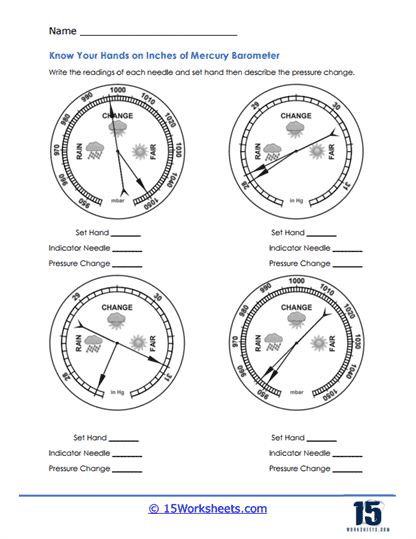Reading Barometers Worksheets
About These 15 Worksheets
These worksheets will help you understand how barometers work and how to interpret the data they provide. These worksheets are commonly used in science and geography classes to teach students about atmospheric pressure and its implications on weather patterns. In this detailed exploration, we’ll cover what these worksheets typically include, the various types of exercises they feature, and how these exercises are beneficial for educational purposes.
Before diving into the specifics of the worksheets, it’s crucial to understand what a barometer is. A barometer is a scientific instrument used to measure atmospheric pressure. This measurement is instrumental in weather prediction, as changes in atmospheric pressure can indicate upcoming changes in the weather. Barometers are also useful in determining altitude, as air pressure decreases with an increase in elevation. This application is particularly important in fields like hiking, aviation, and geology.
Barometers can be either mercury or aneroid, with the former using a column of mercury to measure air pressure and the latter using a sealed air chamber. There are two main types of barometers – mercury barometers and aneroid barometers.
Mercury Barometers – These use a glass tube filled with mercury. Changes in atmospheric pressure cause the mercury level to rise or fall, and the height of the mercury column is then read against a scale. This type was invented by Evangelista Torricelli in 1643.
Aneroid Barometers – These do not use liquid but rather a small, flexible metal box called an aneroid cell. Air is partially removed from the sealed box, allowing the external air pressure to cause the box to expand or contract. These movements are mechanically amplified and displayed on a dial.
Types of Exercises
Reading barometers worksheets are diverse, each designed to target specific learning outcomes related to understanding atmospheric pressure and its effects. The exercises can range from basic interpretation skills to more complex data analysis and application tasks. Here are some of the common types of exercises found on these worksheets:
Identification – These exercises begin with the basics by asking students to identify parts of a barometer. They might include labeled diagrams of both mercury and aneroid barometers, where students need to match the parts with their names and functions. This foundational knowledge is crucial for understanding how barometers work.
Reading Measurements – One of the core skills taught through these worksheets is reading the measurements from different types of barometers. Students might be given images of barometers with different readings and asked to record the pressure shown. This exercise helps in familiarizing them with the scale used in barometers, whether it’s millibars, inches of mercury, or another unit.
Interpreting Barometer Readings – Moving beyond simply reading the measurements, students are often required to interpret what these readings mean in terms of weather patterns. For example, they might be asked to predict the weather conditions associated with a high-pressure reading versus a low-pressure reading. These tasks encourage students to apply their theoretical knowledge to practical scenarios.
Graphical Data Interpretation – These exercises involve charts and graphs that depict changes in atmospheric pressure over time. Students might be tasked with identifying trends, comparing day-to-day changes, and correlating these changes with known weather events. Such exercises enhance their analytical skills and their ability to use data for prediction and analysis.
Scenario-Based Questions – Scenario-based exercises are designed to simulate real-life situations where knowledge of atmospheric pressure is applied. Students might be given a scenario such as planning a picnic and needing to predict the weather conditions based on barometer readings. This type of exercise tests both their understanding of the instrument and their ability to use it in decision-making.
Critical Thinking Questions – To deepen understanding and encourage a comprehensive grasp of the topic, worksheets often include critical thinking questions. These might involve exploring the historical development of the barometer, discussing its impact on meteorology, or debating its reliability and accuracy compared to modern digital tools.
What Do Changes in Air Pressure Tell Us?
Changes in atmospheric pressure can tell us a great deal about upcoming weather conditions:
High Pressure – Generally indicates stable, clear skies and drier air conditions. High pressure areas are often associated with colder, denser air sinking toward the earth, which discourages cloud formation.
Low Pressure – Suggests stormy, rainy, or cloudy weather. Low pressure is associated with rising air, which cools and condenses to form clouds and, potentially, precipitation.
Rapid Changes – Sudden drops in air pressure can indicate that a storm is approaching very quickly, possibly bringing severe weather. A rapid rise might mean that clear skies are likely to follow soon after stormy conditions.
Meteorologists track these changes to provide weather forecasts and storm warnings, helping communities prepare for potential weather hazards. Overall, the barometer is a fundamental tool in both meteorology and environmental science, providing essential data that helps us understand and anticipate weather changes.















